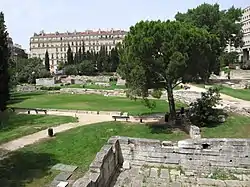Massalia
Massalia (Greek: Μασσαλία; Latin: Massilia; modern Marseille) was an ancient Greek colony founded ca. 600 BC on the Mediterranean coast of present-day France, east of the river Rhône, by Ionian settlers from Phocaea, in Western Anatolia. After the capture of Phocaea by the Persians in 545 BC, a new wave of settlers fled towards the colony.[1][2][3]
History

After the middle of the 6th century BC, Massalia became an important trading post of the western Mediterranean area, and it grew into creating colonies of its own in Gaul during the 4th and 3rd centuries BC: Agathe (late 5th–early 4th c. BC), Olbia (ca. 325), Tauroentium (early 3rd c.), Antipolis and Nikaia (ca. mid-3rd c.).[4][3] Massalia was known in ancient times for its explorers: Euthymenes travelled to the west African coast in the late 6th century BC, and Pytheas explored northwestern Europe in the late 4th century BC.[2]
The colony remained a faithful ally of Rome during all of the Punic Wars (264–146 BC). The retreat of Carthage from the Iberian coast after its defeat in the Second Punic War (218–201) gave Massalia the dominancy over the Gulf of Lion, and the fall of Carthage in 146 probably led to the intensification of trade between the Greek colony and the Celtiberians.[5]
After Massalia chose neutrality during the Civil Wars, the city was besieged and eventually had to surrender to Caesar in 49 BC. Massalia lost most of its territory in the aftermath of this defeat.[3]
During the Roman and Late Antique periods, the city, then known as Massilia in Latin, remained a major center of maritime trade. It became a civitas within the Roman Empire at the latest ca. 300 AD.[3]
Political system
Massalia was ruled as an oligarchic republic by a closed aristocracy descending from the original settlers. An assembly of 600 timouchoi, whose membership was conditioned to the involvement in trading activities, elected 15 magistrates, 3 of them with executive power.[6][3]
Legacy
A genetic study conducted in 2011 found that 4% of the inhabitants of Provence were derived for haplogroup E-V13, which is especially frequent among Phocaeans (19%), and that 17% of the Y-chromosomes in Provence may be attributed to Greek colonization. According to the authors, these results suggest "a Greek male elite-dominant input into the Iron Age Provence population".[7]
References
- Lafond 2006.
- Rivet & Drinkwater 2016.
- Guyon 2012.
- Collin Bouffier 2009, p. 38.
- Collin Bouffier 2009, pp. 38–39.
- Collin Bouffier 2009, pp. 36–37.
- King et al. 2011.
- Bibliography
- Collin Bouffier, Sophie (2009). "Marseille et la Gaule Méditerranéenne avant la Conquête Romaine". In Cabouret, Bernadette (ed.). Rome et l'occident: du IIe s. av. J.-C au IIe s. apr. J.-C. Presses Universitaire du Mirail. pp. 35–60. ISBN 978-2-8107-0052-3. JSTOR 43606588.
- Guyon, Jean (2012). "Massilia (Marseilles)". The Encyclopedia of Ancient History. Wiley-Blackwell. doi:10.1002/9781444338386.wbeah16085. ISBN 978-1-4443-3838-6.
- King, Roy J.; Di Cristofaro, Julie; Kouvatsi, Anastasia; Triantaphyllidis, Costas; Scheidel, Walter; Myres, Natalie M.; Lin, Alice A.; Eissautier, Alexandre; Mitchell, Michael; Binder, Didier; Semino, Ornella (2011). "The coming of the Greeks to Provence and Corsica: Y-chromosome models of archaic Greek colonization of the western Mediterranean". BMC Evolutionary Biology. 11 (1): 69. doi:10.1186/1471-2148-11-69. ISSN 1471-2148. PMC 3068964. PMID 21401952.
- Lafond, Yves (2006). "Massalia". Brill’s New Pauly. doi:10.1163/1574-9347_bnp_e725870.
- Rivet, A. L. F.; Drinkwater, John F. (2016). "Massalia". Oxford Research Encyclopedia of Classics. doi:10.1093/acrefore/9780199381135.013.3997.
Further reading
- Bizot, Bruno (2007). Marseille antique. Guides archéologiques de la France. Éd. du Patrimoine. ISBN 978-2-85822-931-4.
- Loseby, S. T. (1992). "Marseille: A Late Antique Success Story?". The Journal of Roman Studies. 82: 165–185. doi:10.2307/301290. ISSN 1753-528X.